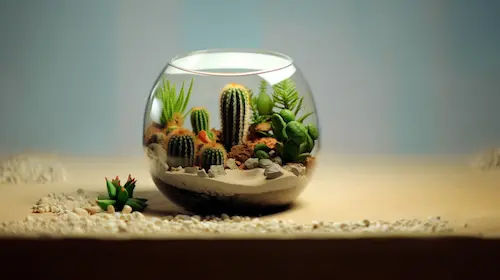Desert Terrarium Singapore

Terrariums in Singapore have gained significant popularity as a creative gardening trend. Among the various types of terrariums, desert terrariums stand out for their unique charm and suitability to Singapore’s climate.
In this guide, we will delve into the world of desert terrariums in Singapore, providing you with valuable insights on how to create and maintain a desert terrarium that thrives in our humid environment.
Creating a well-designed desert terrarium is essential to provide the right conditions for desert plants to flourish. Let’s explore the key factors involved in the process.
Understanding Desert Terrariums

Desert terrariums are distinct from other types of terrariums, such as closed and open terrariums. Unlike closed terrariums that create a humid and self-contained environment, desert terrariums simulate arid conditions with low humidity and minimal moisture.
Opting for desert plants in Singapore’s climate offers several benefits. These plants are well-adapted to survive in drier conditions, making them suitable for the local environment.
Desert plants typically feature succulents, cacti, and other species that thrive in arid regions. They have unique characteristics, such as fleshy leaves, thick stems, and the ability to store water, allowing them to withstand periods of drought.
Setting Up a Desert Terrarium in Singapore

1. Selecting the Right Container
When choosing a container for your desert terrarium, consider factors like size, shape, and material. Opt for containers that provide proper ventilation and drainage, allowing excess moisture to escape.
2. Choosing the Ideal Desert Plants
Browse through a variety of desert plants suitable for Singapore’s climate, including aloe vera, desert rose, and jade plant. Each terrarium plant has specific requirements in terms of light, soil, and moisture. Consider these factors before making your selection.
3. Creating the Desert Environment
Use well-draining soil mixes, such as sandy or gravelly substrates, to mimic arid conditions. Arrange rocks and decorative elements to create an aesthetically pleasing and functional layout within the terrarium.
4. Managing Light and Temperature
Desert plants thrive in direct sunlight. Place your desert terrarium in a spot that receives ample sunlight, such as near a sunny window. Ensure the temperature within the terrarium remains within the optimal range for desert plants’ growth and development.
5. Watering and Humidity Control
Desert plants require infrequent watering due to their water-storing capabilities. Follow a watering schedule that allows the soil to dry out between waterings. Control humidity levels within the terrarium to prevent excessive moisture buildup, which can be detrimental to desert plants.
Maintenance and Care Tips

- Regular Monitoring: Keep a close eye on your desert terrarium’s plants, observing for signs of health or stress. Factors such as leaf discoloration, wilting, or pest infestation may indicate underlying issues that need attention.
- Pruning and Propagation: Prune your desert plants to maintain their shape and health. Propagation techniques, such as stem or leaf cuttings, can help expand your collection or replace aging plants.
- Preventing Pests and Diseases: While desert plants are generally resilient, they can still be susceptible to pests like mealybugs or diseases caused by excessive moisture. Take preventive measures, such as regular inspection and maintaining a clean terrarium environment, to keep your plants healthy.
Desert Terrarium Singapore
Creating and maintaining a desert terrarium in Singapore allows you to enjoy the beauty of desert plants while adapting to our climate. By considering factors such as lighting, temperature, soil, and moisture, you can successfully create a thriving desert terrarium that brings a touch of arid elegance to your home. Embrace the world of desert terrariums and embark on your creative gardening journey today!
Looking to create other types of terrariums instead? Check out our recommendations below:
- Guide to Bonsai Terrariums in Singapore (2025)
- Guide to Succulent Terrariums in Singapore (2025)
- Guide to Air Plant Terrariums in Singapore (2025)
- Guide To Mini Terrariums in Singapore (2025)
- Guide to Cactus Terrariums in Singapore (2025)
- Guide to Glass Terrariums in Singapore (2025)
- Guide to Moss Terrariums in Singapore (2025)
Frequently Asked Questions (FAQ)
If you have any questions about desert terrariums in Singapore, you can refer to the frequently asked questions (FAQ) about the best Guide To Desert Terrariums In Singapore below:
Can I use regular potting soil for my desert terrarium?
No, regular potting soil retains too much moisture for desert terrariums. Opt for well-draining soil mixes formulated specifically for desert plants.
How often should I water my desert terrarium?
Desert terrariums require infrequent watering. Water only when the soil is completely dry, typically every two to four weeks, depending on the plant’s water requirements.
Can I place my desert terrarium in a shaded area?
Desert plants thrive in direct sunlight, so it’s recommended to place your terrarium in a spot that receives ample sunlight for several hours each day.
What are the key factors to consider when choosing desert plants for a terrarium?
When selecting desert plants for your terrarium, consider factors such as their adaptability to Singapore’s climate, their water requirements, preferred light conditions, and growth habits. Choose plants that suit your terrarium’s size and design, ensuring they can thrive in the provided environment.
How do I prevent condensation from building up inside a closed desert terrarium?
Condensation can occur in closed terrariums due to high humidity levels. To reduce condensation, ensure proper ventilation by opening the terrarium periodically to allow excess moisture to escape. You can also use a hygrometer to monitor humidity levels and adjust accordingly.
Can I create a desert terrarium in Singapore using closed or open terrariums, and what plants should I avoid?
While creating a desert terrarium in Singapore, it is recommended to use an open terrarium, as desert plants require good air circulation and less humidity compared to closed terrarium. Avoid using moisture-loving plants like ferns, as they are not suitable for desert terrarium environments.
